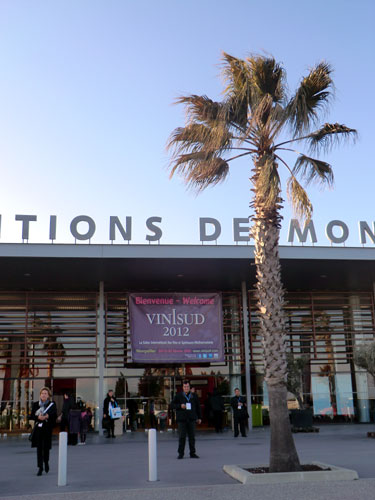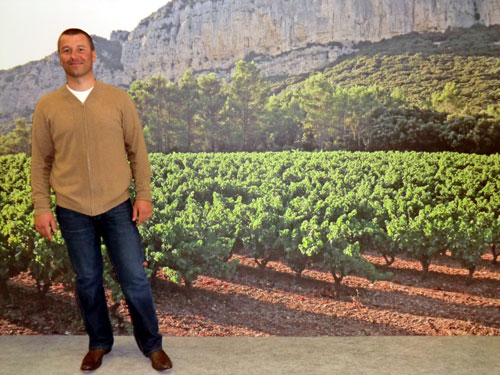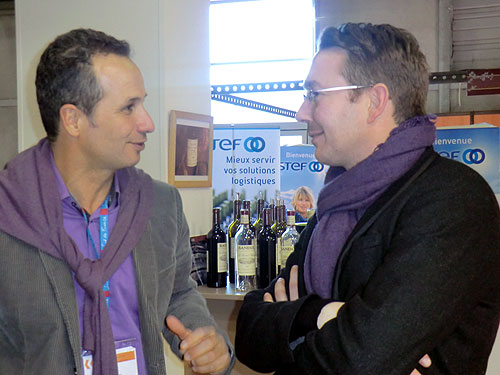After another early departure, we touched down at Nîmes Garons airport in bright sunshine and a biting Mistral. By 10 o’clock we had zipped past flamingos feeding in the Basin de Thau and we were tasting with Roland Géraud from Côtes de Thongue at the Parc des Expositions in Montpellier. Vinisud is a big and buzzing Fair focused on Mediterranean wines that attracts over 30,000 professional buyers and takes place once every two years. The attraction for us is that we can catch up on all the latest news and developments with over 20 of our winemaker friends and taste the latest vintages.

Vinisud - Parc des Expositions - Montpellier
Over two days we tasted well over one hundred wines, predominantly from a strong trio of vintages 2009, 2010 and 2011. While 2009 and 2010 have been universally acclaimed as first-class years throughout France, 2011 requires more careful consideration. The hot Spring was followed by a cool Summer and a warm late-ripening season. Winemakers who hand-harvested (over a long period) and were diligent with their grape selection have made very good wines.

Xavier Bruguière from Pic St Loup
Standout highlights of an intensive two days were Domaine Torraccia’s Corsican red 2009 (which garnered a ‘Coup de Coeur’ in the Guide Hachette), Richard Maby’s white Lirac 2011 (his finest to date) and Alain Graillot’s sublime red Crozes Hermitage 2010.

Tom Ashworth & Laurent Bunan from Bandol Talk Scarves
We filed this copy in the sunshine on the terrace of the Café d’Esplanade in Uzes, looking forward to shipping a trifecta of terrific vintages back to the UK.
The England versus France rugby match, ‘Le Crunch’, that takes place at Twickenham every other year affords us a royal opportunity to make merry with our winemaker friends from across La Manche. This year Messrs Pascal Labasse, Vincent Cantié and Maxime Graillot travelled over for the weekend with high expectations for ‘Les Bleus’.
This enabled us to furnish the traditional pre-match car park picnic (superbly organised by my old friend Charles Allen) with lashings of Jurançon sec, Collioure: La Pinède and Crozes Hermitage: Domaine des Lises. Pascal commented that it was a treat to be able to drink his own wine in shadow of the West stand while entertaining high hopes for the match ahead.
Charles’ catering team, undaunted by the fact that our party had been joined by restaurateurs from Le Gavroche, Café Anglais and Chabrot, had sportingly provided a well-balanced menu with two main courses – a Gallic Beef Bourgignon and England’s most popular dish, Chicken Curry.
There was as much debate as to which red went best with the curry as there was on who would score the first try, but there was unanimous agreement that Vincent Cantie’s excellent Domaine la Tour Vieille: Banyuls Réserva was an ideal partner for the Chocolate Brownies and Pascal’s sweet Jurançon was as well-balanced a unit with the blue cheese as the English back row.
A torrential shower an hour before kick-off did little to dampen spirits and, unusually, the French saw this as a good omen, potentially negating ‘le Engleesh flair’. Sadly (pour eux), it was not to be and in a tight, physical contest ‘Les Rosbifs’ came out as winners. Our guests took it well and any dark mumblings about the referee-ing quality were quickly banished by post-match digestifs. Match analysis went long into the night, accompanied by toasts to good health, long lives and friendships augmented, with promises to do it all again in 2013.
(Continuing the voyage down the Rhône valley this week, to catch up with vigneron friends and get an insight into the Rhône 2009 vintage).
Domaine Jean-Louis Chave is a key reference point for the entire Rhône valley, and securing an audience with Jean-Louis himself is never easy. Space precludes going into too much detail here, but the red Chave Hermitage 2009 has the potential to be a legendary wine and on the strength of our cask tasting I would be surprised if Jean-Louis did not produce a bottling of his prized Cuvée Cathelin. All of the components that are required for a classic, age-worthy red Hermitage are here – a wealth of dark fruit flavours and well-structured tannins underscored by a fine acidity. The finished wine won’t hit these shores until Spring 2012, but it will be worth the wait. Not to be overlooked is the Chave’s peerless white Hermitage which should also be ‘bien classique’ in this impressive vintage.
Just South of Tain l’Hermitage, at Les Chenes Verts, young Maxime Graillot exudes confidence at the purpose-built winery he shares with his semi-retired father Alain. Their red Crozes Hermitage is juicy and fruity and will provide rewarding drinking from the off. A new negoçiant cuvée of Cornas called ‘Equis’ was hugely impressive with a core of dark Cassis fruit over a foundation of ripe, subtle tannins. We wound up a great day’s tasting with the Graillots’ fresh, youthful white Crozes (20% Marsanne / 80% Roussanne) already bottled under screw cap and selling rapidly.
Tomorrow we head south for Châteauneuf-du-Pape to see if the wines of the Cotes-du-Rhone Meridional can compete with their cousins in the North.
À demain (hotel wi-fi permitting),
Jason & Tom
Last week, we were blessed with a whistle-stop visit from our old friend Crozes Hermitage maestro Alain Graillot and his charming wife (and administrative guru) Elisabeth. Alain graciously agreed to talk us through a flight of his wines and elaborate on his wine making philosophy as well as fielding questions from our inquisitive team in Mere.
Alain (who fortunately speaks excellent English) told us how he had become a first generation winemaker comparatively late in life on the eve of his 40th birthday back in 1985. After a successful international career in agro-chemicals Alain decided to pursue his dream and found a 17 hectare vineyard to rent on Le Chassis plain below Tain l'Hermitage. Alain was drawn to Crozes Hermitage because he is partial to Syrah and had been buying wines from the likes of Marcel Guigal, Paul Jaboulet and Jean-Louis Grippat for his personal cellar and also because land there was relatively affordable and he was able to get a toe-hold without enormous borrowings.
From the outset Alain has tried to produce "wines that are affordable and that people will want to drink". This game plan has served him well and he was able to buy the vineyard in 1988 and this year has overseen a huge excavation project to extend his cellars to accommodate his son Maxime's wine production from a neighbouring estate called 'Domaine des Lises'. Alain is candid that his retirement plans revolve around 32 year-old Maxime's ability to take over the day to day running of the operation and he is looking forward to working less hard!
We started our tasting with Alain's white Crozes Hermitage 2008 that is made from a blend of 80% Marsanne and 20% Roussanne and is a comparative rarity accounting for just 1 seventh of production. This fresh, youthful wine is, in Alain's opinion, best drunk in its first 3-4 years so he has decided to bottle it under Stelvin® scewcap. This policy has met with a mixed reception in France (which accounts for half of sales) but Alain is convinced it is the best way forward for fruity, early-drinking wines.
The first red we tasted was Alain's 2007 Saint Joseph, from just over half a hectare of Syrah vines that Alain rents at Saint Désirat. Alain explained that he is really looking for fruit "above all else" in his Saint Joseph and although this is very much a side line it is a wonderfully juicy and accessible wine with lots of bright red berry flavours and very supple tannins. Interestingly Alain told us that, on account of the granite soil that can yield hard tannin, he always de-stems all of his Saint Joseph but he never de-stems his Crozes Hermitage.
Our next wine was the 2007 Crozes Hermitage rouge that Alain admitted he was proud of as it was a vintage that required a great deal of effort and was never a predetermined success. This was darker, fuller and more complex than the Saint Joseph but was showing very well on its youthful fruit. We followed this with the same wine in the 2006 vintage which was denser, more closed and restrained with much less fruit on the nose. Alain explained that one is better off drinking Northern Rhône Syrah when really young (within a year or so of bottling) or keeping it for at least 3 years to develop some bottle age. To illustrate this point we then tasted the red Crozes' 1995 which was a great vintage and just coming into its stride with more secondary leather, chocolate, and sous bois aromas and a fine palate of black fruit that still had plenty of vigour. Alain told us not to underestimate the longevity of Syrah and that last year he tasted through a retrospective vertical of all of the wines he had made and that even his 2 most fraught vintages (1993 and 2002) were still 'alive' and enjoyable.
The final wine in this line-up was a real treat, Alain's 'La Guiraude' 2005. The La Guiraude is a barrel selection or Cuvée du Patron that Alain blends when the correct conditions prevail and can represent up to 10% of his red production. Although 2005 was a terrific vintage this wine is made to be laid down and was still very much in its infancy. It was showing more concentration and fuller and rounder tannins than the 'regular' Crozes' with a wealth of black fruit and good acidity - it should be an absolute belter given a further 3-5 years.
Before he headed for the hills we asked Alain what he thought was the secret of his winemaking success. "A fresh finish" was his immediate response because "that provides the incentive for the next glass". We couldn't agree more.
On Day 3, we were up and at ‘em with a climat by climat barrel-tasting of the 2007 Hermitage at the Rhône valley’s most prestigious address – Domaine Jean-Louis Chave in the village of Mauves. The Chaves farm just under 14 of Hermitages precious 131 hectares and have an unbroken ‘de père en fils’ lineage stretching back to 1481. They have vines in 9 different sites on the hill of Hermitage so this was quite a protracted tasting. Here Jean-Louis Chave patiently explained the different attributes of fruit from different parcels of vines in what amounted to a masterclass in the concept of terroir or the impact of location on taste. Jean-Louis told us that 2007 is ‘Un bon millésime’ for his Hermitage – not a blockbuster but a vintage of flesh and fruit ‘a bit like 1997 or 2000’ that should drink well soon after bottling – we wouldn’t disagree.
Our final tasting of the trip was with Alain Graillot and his son Maxime at Les Chênes Verts on Le Chassis plateau of Crozes-Hermitage. The Graillots 2007’s are bursting with black fruit flavours and one could happily drink them right off the bat. Despite the current economic gloom Graillot ‘Père et Fils’ are upbeat about business explaining that demand for their relatively inexpensive, early-drinking Syrahs is strong at the moment as people are looking for value on restaurant wine lists and aren’t buying grander bottles. This has always been a modern, forward-thinking operation and there is much evidence of innovation and re-investment. A substantial new cellar and wine store are being excavated to increase capacity for Maxime’s new négociant projects in Saint Joseph and Cornas. Also Alain’s superb, mineral-edged white Crozes’ has been bottled under screw-cap for the first time in the 2008 vintage which should show its clean apricot fruit to full advantage.
After our tasting and tour we headed back into Tain’ for a wonderful al fresco lunch of modern Mediterranean cuisine on the terrace of Le Quai restaurant where we enjoyed a bottle of Jean-Louis Thiers’ 2007 Saint Péray Nature and Alain’s own 2007 red Saint Joseph - which is supple and sapid and ideal for outdoor drinking.
After lunch we piled back into our rented ride and headed south for Avignon. There we checked into the basic but central Hotel Garlande and strolled around the town for an obligatory look at what’s left of the Pont.
Our mission completed with myriad tasting notes, a raft of photographs and a few very fine meals under our belts it was a pleasure to sit in the sunshine in the Place de l’Horloge and sip a glass of Domaine Maby’s delightful 2007 Tavel rosé which La Civette Brasserie bangs out at a not unreasonable 19 euros a bottle. It’s a tough job – but someone’s got to do it!








